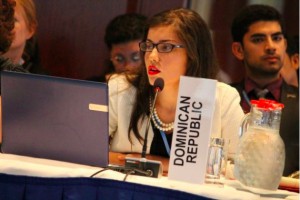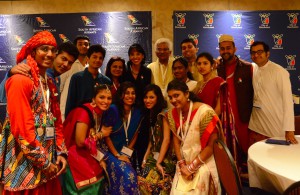. SUSTAINABLE DEVELOPMENT .
An article by Victor Grossman, Counterpunch
I defied my advanced age last week to board a special train, with a thousand mostly young people, and join in the big “Blockupy” demonstration in Frankfurt/Main, Germany’s big banking city. The trip, though not the usual 4 ½ but seven hours, retained till well into the night a spirit of happy anticipation.

Click on photo to enlarge
Photo from left-flank.org
Hardly one year old, Podemos is already vying for the top spot in Spanish polls. This precocious The occasion was the opening of a giant new European Central Bank building, over four years and $1.4 billion in the making, one more modernistic banking skyscraper to reshape the city’s skyline, with two adjacent towers reaching up 201 meters (660 ft.). Our aim was to protest and disrupt the ceremonies, the role of the bank and the entire policy of the European Union of forcing austerity policies on its members and especially trying to compel Greece’s new Syriza government to further bankrupt itself by paying excessive foreign bank debts and thus abandoning its goal of relieving the misery of countless jobless, hungry citizens, their loss of even basic medical care and often enough of any livelihood whatsoever.
Our slow train’s midnight arrival caused my little group to miss the early hours of protest the next day, March 18th – which had in part been violent hours. The Blockupy organizers, from a wide variety of organizations, had planned to prevent normal ceremonies by means of non-violent actions, sitting or standing to blockade the entranceways to the bank, with street theater and waves of umbrellas with painted slogans.
About 6000 people did just that – and certainly spoiled the ceremonial show. Hardly more than a handful of prominent guests had been invited, with police escort, to slip past the demonstrators for a very subdued event – and only six journalists, not even one from Frankfurt’s main newspapers (to their great indignation). This was a big success – for Blockupy.
But, even earlier, about a thousand demonstrators, apparently from the masked “black bloc”, had come hunting for greater trouble. Ten thousand police, detachments from all over Germany, having prepared for months for an expected remmi-demmi (the German word sounds wilder and apter than hubbub or tumult), confronted them with water cannon and tear gas. Who started things off is in dispute, but the free-for-all battle erupted into hails of plaster stones and other hard objects, burning cars and emptied, burnt out dumpsters, clouds of various chemicals, many injuries on both sides, countless arrests and huge pillars of smoke darkening the sky.
Since our slow train from Berlin had arrived after midnight, my small group slept to long and didn’t get to the fenced-off area near the skyscraper until nearly 9 AM. The police units and water cannon vehicles, some resembling tanks, seemed now at rest. Our march though a downtown area moved along peacefully, with many at the windows in this largely Turkish neighborhood answering our waves with V signs.
All of a sudden, who knows why, we were halted by a tight police cordon. After a menacingly close face-off they came at us in a brief attack (and I nearly got knocked over by tough, visored, protectively-covered cops). Thanks perhaps to constant, clear appeals for calm by the loud-speaker voices on our side, the attack ended and the police withdrew – to great cheers.
(continued into discussion on right side of this page)
Question for this article:
Movements against governmental fiscal austerity, are they part of the global movement for a culture of peace?
Readers’ comments are invited on this question.
(continuation of article from left side of page:)
After that I saw nothing but great enthusiasm – and determination. In the afternoon, on Frankfurt’s historic Roemer square where German kings and Holy Roman Emperors were once elected, we heard speeches by representatives of organizations backing the Blockupy movement – and it is indeed a movement, three years old, inspired by Occupy in the USA. One spoke for the Greek Syriza Party; the Canadian Naomi Klein, in dramatic words, made it trans-Atlantic. Then the big parade started off. And it was big, seeming almost endless, with over 20,000 people, some from Spain, Italy and Greece but mostly from German peace groups, anti-imperialist and leftist groups of various persuasions, the Attac organization, which has long demanded taxes on financial speculation, and large numbers from the co-sponsoring Linke (Left) party. Also, quite significantly, the Hesse state section of Germany’s often stand-offish union federation, the DGB, whose originally separate parade then merged symbolically with the main group.
Countless signs aimed at the main proponents of European austerity, Angela Merkel and her foxy, arrogant and merciless Finance Minister Wolfgang Schäuble. Others denounced the anti-immigrant, anti-foreigner, Muslimophobic actions of PEGIDA and openly neo-Nazi or hooligan groups, stating instead, “We welcome asylum seekers”. Many were witty, like: “Not Austerity but Oysters“ (both words are spelled very similarly in German) and “Caviar for Everybody”. The so-called “Troika” group was often lambasted. Its members, the European Commission, the International Monetary Fund (IMF) and the European Central Bank (now with a new skyscraper), had attained notoriety by dictating to the former Greek government what austerity measures it must adopt. Currently, with a new name, it was trying to compel the Syriza government to buckle under in the same way, and many signs read “Hands off Greece”. One longer text said: “Stop Troika Austerity – It’s All for the Banks and the Top 1 Percent”. Others attacked the banks on ecology issues, opposing the planned transatlantic version of NAFTA, gene-altered vegetables, antibiotics-stuffed meat (and on a few signs, meat at all).
Some slogans which reacted to the stern, unbending resolution of European leaders like Merkel never to let any member country ever move even inches towards socialism or any truly progressive policies, for fear that this could become infectious – in Spain, Portugal, even Italy or Ireland. Not a few signs called for just such socialist solutions to systemic downfall.
The masked “black bloc” marched along , too, though in a leaflet I was given, after a page full of super-rrrrevolutionary clichés, they ended with the call: “Let Us Cease Protesting, Let Us Begin Destroying”. Who knows, their morning attacks (and a few in the evening after most people had left) would not be the first ones involving masked agents provocateurs from the powers-that-be? But perhaps they were not necessary for these plate-glass-smashing lovers of such remmi-demmis. Some of the sponsoring groups apologized for their actions, others answered that there seemed to be more anger over two hours of damage done here than over years of evictions, hungry children and suicides in Greece – or drone killings in Afghanistan, Pakistan or Yemen. Most agreed, however, that these methods – and groups – should be kept out of further actions if at all possible.
Of course the media rejoiced in the battle scenes and featured that cloud over Frankfurt, playing down the message of a truly great event. But its message was clear. The Merkel government had led the European Union in pressuring Greece, disregarding the terrible hardships there. For some years most of the media, led as always by the mass newspaper, BILD, had denounced the Greek people as lazy, pampered, neglectful of repaying their debts at the cost of German taxpayers. This pure chauvinism had been far too successful, in part because the unions had hardly opposed it and the left was not strong enough to have much influence in the matter. This Blockupy demonstration was an attempt to break through the fog – and point out that crushing the Greek people was one step towards crushing working people elsewhere, also in Germany, and that they needed not disdain or worse but rather solidarity from Germans.
Blockupy was an attempt to gather disparate groups, despite their differences, into a solid force, not only on the question of Greece but against the highway robbery tactics of the powerful private German banks as well. Perhaps, hopefully, it might be the germ of a stronger, combined movement in relatively docile Germany against two menacing dangers. One was the PEGIDA movement and its allies, like the growing new party Alternate for Germany (AfD), which was steering dissatisfaction, distrust of politicians and worries about an uncertain economic future away from those really responsible forces but instead against the poorest, most disadvantaged group in Germany (and elsewhere), the immigrants and asylum-seekers, mostly Muslim, from the Near East or Africa. And too many from the governing parties had begun to dilute their abhorrence of this nasty bunch.
The other danger, also constantly stirred up by most of the media, was the “Hate Russia, Hate Putin” campaign, which could only increase the terrible danger of war over the Ukraine. Germany was leading the attacks against Greece. But in the question of Russia and the Ukraine it was still teetering between US pressure to build up NATO armaments and test them in insane maneuvers right along the Russian border and in the Black Sea, a policy with powerful supporters in Germany and other EU members or, instead, saner attempts, supported by other business interests, to help cool the scene and try to make the Minsk peace efforts succeed. Most Germans wanted urgently to maintain peace, but their voices were not easily audible. To alter this imbalance and help avoid the worst required giant efforts by many in Germany, most importantly the LINKE party – not only with its 64 members in the Bundestag but far more importantly in the streets – as in Frankfurt. Would the Blockupy movement fade away – or grow to meet these needs, joining sister groups on a European level? The answer could be very crucial!









